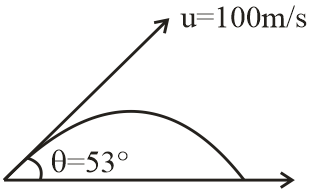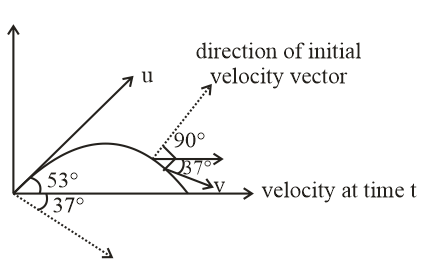
For the given projectile as shown, the time $($in seconds$)$ after which the angle between velocity vector and initial velocity vector becomes $\dfrac{\pi }{2}$ is $(u = 100m/s)$

(A) $\dfrac{{50}}{4}$
(B) $\dfrac{{100}}{3}$
(C) $\dfrac{{14}}{3}$
(D) $\dfrac{{28}}{3}$

Answer
563.7k+ views
Hint: In order to solve above problem first calculate, the initial velocity vector component in x and y direction i.e.,
${u_x} = u\cos \theta $
${u_y} = u\sin \theta $
$u = $Initial velocity vector
${u_x} = $x component of Initial velocity vector
${u_y} = $y component of Initial velocity vector
After then calculate the velocity vector at time t and also calculate the velocity vector component in x and y direction with the help of newton’s first equation. Now, on comparing the both velocity components, we will get a desired solution.
Complete step by step answer:
Given that initial velocity $u = 100m/s$ and the angle at which the particle is projected initially is $\theta = 53^\circ $.
So, x-component of initial velocity ${u_x} = u\cos \theta $
${u_x} = 100\cos 53^\circ $
$ \Rightarrow {u_x} = 100\left( {\dfrac{3}{5}} \right)$ $\left[ {\because \cos 53^\circ = \dfrac{3}{5}} \right]$
$ \Rightarrow {u_x} = \dfrac{{300}}{5}$
$ \Rightarrow {u_x} = 60$ …..(1)
And y-component of initial velocity ${u_y} = u\sin \theta $
${u_y} = 100sin53^\circ $
$ \Rightarrow {u_y} = 100\left( {\dfrac{4}{5}} \right)$ $\left[ {\because \sin 53^\circ = \dfrac{4}{5}} \right]$
$ \Rightarrow {u_y} = \dfrac{{400}}{5}$
$ \Rightarrow {u_y} = 80$ …..(2)
Now, according to the given in question the angle between velocity vector at time t and initial velocity vector becomes $\dfrac{\pi }{2}$ i.e., 90. Here we can easily understand this thing with diagram as –

In the diagram we can easily see that at time t the angle of velocity vector $(\overrightarrow v )$ with horizontal as $37^\circ $.
So, the x-component of velocity vector $\overrightarrow v $ is
${v_x} = v\cos \theta $ $[$Here $\theta = 37^\circ ]$
We know that the x-component of velocity does not change during the whole motion of the projectile because acceleration in x-direction is zero.
Here ${v_x} = $x component of velocity vector$v$at time$t$
So, ${v_x} = {u_x}$
So, from equation 1
$ \Rightarrow {v_x} = 60$
So, $v\cos 37^\circ = 60$
$ \Rightarrow v = \dfrac{{60}}{{\cos 37^\circ }}$
$\because \cos 37^\circ = \dfrac{4}{5}$
$ \Rightarrow v = \dfrac{{60 \times 5}}{4}$
$ \Rightarrow v = \dfrac{{300}}{4}$
$ \Rightarrow v = 75m/s$
Hence, the velocity at time t is 75m/s
Now, the y-component of velocity vector at time t is
${v_y} = - v\sin 37^\circ $
$ \Rightarrow {v_y} = - \left( {75 \times \dfrac{3}{5}} \right)$ $\left[ {\because \sin 37^\circ = \dfrac{3}{5}} \right]$
$ \Rightarrow {v_y} = - (15 \times 3)$
$ \Rightarrow {v_y} = - 45$ …..(3)
Here –ve sign represents the downward direction.
So, we can write newton’s first equation for y-component of velocity vector at time t as
${v_y} = {u_y} + {a_y}t$
Here ${a_y} = $acceleration in y direction
$\because {a_y} = - g = - 10m/{s^2}$
So, from equation 2 and 3
$ \Rightarrow - 45 = 80 - 10t$
$ \Rightarrow - 45 - 80 = - 10t$
$ \Rightarrow t = \dfrac{{ - 125}}{{ - 10}}$
$ \Rightarrow t = \dfrac{{125}}{{10}}$
$ \Rightarrow t = \dfrac{{25}}{2}\sec $
Now divide and multiply with 2 then
$t = \dfrac{{25 \times 2}}{{2 \times 2}}$
$ \Rightarrow t = \dfrac{{50}}{4}\sec $
Therefore, option A is the correct answer.
Note:
Alternatively,
We know that, the x-component of initial velocity is
${u_x} = u\cos \theta $

The y-component of initial velocity is
${u_y} = u\sin \theta $
So, initial velocity vector
$\overrightarrow u = {u_x}\widehat i + {u_y}\widehat j$
$\overrightarrow u = (u\cos \theta )\widehat i + (u\sin \theta )\widehat j$ …..(1)
At time t, the velocity vector is given as
$\overrightarrow v = {v_x}\widehat i + {v_y}\widehat j$
Here ${v_x} = v\cos (90 - \theta ) = v\sin \theta $
Because x-component of velocity does not changes
So, ${v_x} = {u_x}$
Now, from newton’s first equation
${v_y} = ({u_y} - gt)$
So, $\overrightarrow v = {u_x}\widehat i + ({u_y} - gt)\widehat j$
$\overrightarrow v = (u\cos \theta )\widehat i + (u\sin \theta - gt)\widehat j$ …..(2)
Given that at time t, $\overrightarrow v $ and $\overrightarrow u $ are perpendicular to each other.
So, $\overrightarrow u \cdot \overrightarrow v = 0$
From equation 1 and 2
$[(u\cos \theta )\widehat i + (u\sin \theta )\widehat j] \cdot [(u\cos \theta )\widehat i + (u\sin \theta - gt)\widehat j] = 0$
${u^2}{\cos ^2}\theta + (u\sin \theta )(u\sin \theta - gt) = 0$
$\implies {u^2}{\cos ^2}\theta + {u^2}{\sin ^2}\theta - ugt\sin \theta = 0$
$\implies {u^2}({\cos ^2}\theta + {\sin ^2}\theta ) = ugt\sin \theta $
$\implies {\cos ^2}\theta + {\sin ^2}\theta = 1$
$\implies {u^2} = ugt\sin \theta $
$\implies t = \dfrac{{{u^2}}}{{ug\sin \theta }}$
$\implies t = \dfrac{u}{{g\sin \theta }}$
Here u = initial velocity vector
g = acceleration due to gravity
given that
$u = 100m/s$
$g = 10m/{s^2}$
$\theta = 53^\circ $
So, $t = \dfrac{{100}}{{10\sin 53^\circ }}$
$\because \sin 53^\circ = \dfrac{4}{5}$
$t = \dfrac{{100}}{{10 \times \dfrac{4}{5}}}$
$\implies t = \dfrac{{10 \times 5}}{4}$
$\therefore t = \dfrac{{50}}{4}\sec $
${u_x} = u\cos \theta $
${u_y} = u\sin \theta $
$u = $Initial velocity vector
${u_x} = $x component of Initial velocity vector
${u_y} = $y component of Initial velocity vector
After then calculate the velocity vector at time t and also calculate the velocity vector component in x and y direction with the help of newton’s first equation. Now, on comparing the both velocity components, we will get a desired solution.
Complete step by step answer:
Given that initial velocity $u = 100m/s$ and the angle at which the particle is projected initially is $\theta = 53^\circ $.
So, x-component of initial velocity ${u_x} = u\cos \theta $
${u_x} = 100\cos 53^\circ $
$ \Rightarrow {u_x} = 100\left( {\dfrac{3}{5}} \right)$ $\left[ {\because \cos 53^\circ = \dfrac{3}{5}} \right]$
$ \Rightarrow {u_x} = \dfrac{{300}}{5}$
$ \Rightarrow {u_x} = 60$ …..(1)
And y-component of initial velocity ${u_y} = u\sin \theta $
${u_y} = 100sin53^\circ $
$ \Rightarrow {u_y} = 100\left( {\dfrac{4}{5}} \right)$ $\left[ {\because \sin 53^\circ = \dfrac{4}{5}} \right]$
$ \Rightarrow {u_y} = \dfrac{{400}}{5}$
$ \Rightarrow {u_y} = 80$ …..(2)
Now, according to the given in question the angle between velocity vector at time t and initial velocity vector becomes $\dfrac{\pi }{2}$ i.e., 90. Here we can easily understand this thing with diagram as –

In the diagram we can easily see that at time t the angle of velocity vector $(\overrightarrow v )$ with horizontal as $37^\circ $.
So, the x-component of velocity vector $\overrightarrow v $ is
${v_x} = v\cos \theta $ $[$Here $\theta = 37^\circ ]$
We know that the x-component of velocity does not change during the whole motion of the projectile because acceleration in x-direction is zero.
Here ${v_x} = $x component of velocity vector$v$at time$t$
So, ${v_x} = {u_x}$
So, from equation 1
$ \Rightarrow {v_x} = 60$
So, $v\cos 37^\circ = 60$
$ \Rightarrow v = \dfrac{{60}}{{\cos 37^\circ }}$
$\because \cos 37^\circ = \dfrac{4}{5}$
$ \Rightarrow v = \dfrac{{60 \times 5}}{4}$
$ \Rightarrow v = \dfrac{{300}}{4}$
$ \Rightarrow v = 75m/s$
Hence, the velocity at time t is 75m/s
Now, the y-component of velocity vector at time t is
${v_y} = - v\sin 37^\circ $
$ \Rightarrow {v_y} = - \left( {75 \times \dfrac{3}{5}} \right)$ $\left[ {\because \sin 37^\circ = \dfrac{3}{5}} \right]$
$ \Rightarrow {v_y} = - (15 \times 3)$
$ \Rightarrow {v_y} = - 45$ …..(3)
Here –ve sign represents the downward direction.
So, we can write newton’s first equation for y-component of velocity vector at time t as
${v_y} = {u_y} + {a_y}t$
Here ${a_y} = $acceleration in y direction
$\because {a_y} = - g = - 10m/{s^2}$
So, from equation 2 and 3
$ \Rightarrow - 45 = 80 - 10t$
$ \Rightarrow - 45 - 80 = - 10t$
$ \Rightarrow t = \dfrac{{ - 125}}{{ - 10}}$
$ \Rightarrow t = \dfrac{{125}}{{10}}$
$ \Rightarrow t = \dfrac{{25}}{2}\sec $
Now divide and multiply with 2 then
$t = \dfrac{{25 \times 2}}{{2 \times 2}}$
$ \Rightarrow t = \dfrac{{50}}{4}\sec $
Therefore, option A is the correct answer.
Note:
Alternatively,
We know that, the x-component of initial velocity is
${u_x} = u\cos \theta $

The y-component of initial velocity is
${u_y} = u\sin \theta $
So, initial velocity vector
$\overrightarrow u = {u_x}\widehat i + {u_y}\widehat j$
$\overrightarrow u = (u\cos \theta )\widehat i + (u\sin \theta )\widehat j$ …..(1)
At time t, the velocity vector is given as
$\overrightarrow v = {v_x}\widehat i + {v_y}\widehat j$
Here ${v_x} = v\cos (90 - \theta ) = v\sin \theta $
Because x-component of velocity does not changes
So, ${v_x} = {u_x}$
Now, from newton’s first equation
${v_y} = ({u_y} - gt)$
So, $\overrightarrow v = {u_x}\widehat i + ({u_y} - gt)\widehat j$
$\overrightarrow v = (u\cos \theta )\widehat i + (u\sin \theta - gt)\widehat j$ …..(2)
Given that at time t, $\overrightarrow v $ and $\overrightarrow u $ are perpendicular to each other.
So, $\overrightarrow u \cdot \overrightarrow v = 0$
From equation 1 and 2
$[(u\cos \theta )\widehat i + (u\sin \theta )\widehat j] \cdot [(u\cos \theta )\widehat i + (u\sin \theta - gt)\widehat j] = 0$
${u^2}{\cos ^2}\theta + (u\sin \theta )(u\sin \theta - gt) = 0$
$\implies {u^2}{\cos ^2}\theta + {u^2}{\sin ^2}\theta - ugt\sin \theta = 0$
$\implies {u^2}({\cos ^2}\theta + {\sin ^2}\theta ) = ugt\sin \theta $
$\implies {\cos ^2}\theta + {\sin ^2}\theta = 1$
$\implies {u^2} = ugt\sin \theta $
$\implies t = \dfrac{{{u^2}}}{{ug\sin \theta }}$
$\implies t = \dfrac{u}{{g\sin \theta }}$
Here u = initial velocity vector
g = acceleration due to gravity
given that
$u = 100m/s$
$g = 10m/{s^2}$
$\theta = 53^\circ $
So, $t = \dfrac{{100}}{{10\sin 53^\circ }}$
$\because \sin 53^\circ = \dfrac{4}{5}$
$t = \dfrac{{100}}{{10 \times \dfrac{4}{5}}}$
$\implies t = \dfrac{{10 \times 5}}{4}$
$\therefore t = \dfrac{{50}}{4}\sec $
Recently Updated Pages
Why are manures considered better than fertilizers class 11 biology CBSE

Find the coordinates of the midpoint of the line segment class 11 maths CBSE

Distinguish between static friction limiting friction class 11 physics CBSE

The Chairman of the constituent Assembly was A Jawaharlal class 11 social science CBSE

The first National Commission on Labour NCL submitted class 11 social science CBSE

Number of all subshell of n + l 7 is A 4 B 5 C 6 D class 11 chemistry CBSE

Trending doubts
What is meant by exothermic and endothermic reactions class 11 chemistry CBSE

10 examples of friction in our daily life

One Metric ton is equal to kg A 10000 B 1000 C 100 class 11 physics CBSE

1 Quintal is equal to a 110 kg b 10 kg c 100kg d 1000 class 11 physics CBSE

Difference Between Prokaryotic Cells and Eukaryotic Cells

What are Quantum numbers Explain the quantum number class 11 chemistry CBSE




